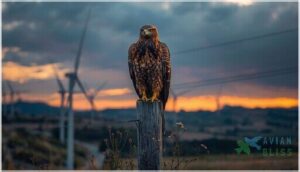This site is supported by our readers. We may earn a commission, at no cost to you, if you purchase through links.

A golden eagle can spot a rabbit from over a mile away. This bird combines size, power, and precision in ways that few other raptors can match. You’ll find them soaring over open country from Alaska to Mexico, riding thermals with wings that span six to seven feet.
Their dark brown plumage and distinctive golden nape make them unmistakable once you know what to look for. But identifying them takes practice, especially when you’re trying to distinguish juveniles with their bold white wing patches from mature adults.
These eagles face real threats today, from lead poisoning to wind turbine collisions, yet they remain one of North America’s most impressive predators.
Table Of Contents
- Key Takeaways
- Golden Eagle Identification and Features
- Golden Eagle Habitat and Range
- Golden Eagle Behavior and Diet
- Golden Eagle Nesting and Reproduction
- Golden Eagle Conservation and Threats
- Frequently Asked Questions (FAQs)
- What states do golden eagles live in?
- Are golden eagles bigger than bald eagles?
- What is the biggest thing a golden eagle can carry?
- Which is bigger Bald or golden eagle?
- Is it rare to see a golden eagle?
- What is special about a golden eagle?
- What do golden eagles eat?
- How long do golden eagles live?
- Are golden eagles endangered?
- How fast can golden eagles fly?
- Conclusion
Key Takeaways
- Golden eagles rely on specialized adaptations—including vision up to eight times sharper than humans and talons delivering several hundred psi of grip pressure—that make them precision predators capable of spotting prey from over a mile away.
- You can identify golden eagles by their dark brown plumage with a distinctive golden nape, and juveniles show bold white wing patches that disappear over five years as they mature into adults.
- Lead poisoning from ingested ammunition kills roughly 17% of golden eagles in documented cases, while wind turbine collisions claim an estimated 270 birds yearly in the western United States alone.
- Golden eagles maintain fierce breeding territories extending at least four miles from their nests, building stick structures on cliff ledges that can reach 20 feet tall through decades of reuse and additions.
Golden Eagle Identification and Features
Spotting a Golden Eagle in the wild is easier when you know what to look for.
These powerful raptors have distinct features that set them apart from other large birds. Let’s break down the key traits that help you identify a Golden Eagle with confidence.
Distinctive Plumage and Coloration
At first glance, adult plumage shows dark brown feathers across the body with a striking golden nape that gives this raptor its name. Juvenile birds display bold white patches on their wings and tail base—diagnostic marks you can spot from a distance. These feather patterns change over five years as immature eagles gradually lose their white markings.
Golden eagles differ, because they’ve feathered legs while bald eagles don’t. Subspecies variation and feather pigments create slight color differences across their range.
Size, Wingspan, and Shape
Beyond plumage, you’ll notice golden eagles rank among North America’s largest raptors. Measurement challenges arise in the field, but wingspan generally reaches 6 to 7 feet. As a top predator, they’re known to hunt medium-sized mammals. Sexual dimorphism means females outweigh males by a full kilogram or more.
Flight morphology reveals:
- Long, broad wings with fingered primary tips
- Rectangular mid-span shape for efficient soaring
- High aspect ratio wing design
Size comparisons show these eagles dwarf red-tailed hawks and most buteos.
Differences Between Adults and Immatures
Identifying immature eagles from adults comes down to plumage variations. Juveniles show bold white wing patches and a white tail base with a dark band—both absent in fully mature birds.
Between 2 and 5 years, plumage change happens through annual molts. Tail markings shift from bicolored to dark brown. Wing patterns gradually lose white.
Age indicators blur between older immatures and adults, creating field identification challenges.
Key Physical Adaptations
Golden eagles possess specialized tools that define them as top predators. Their physical capabilities exceed most raptors through precise anatomical refinements.
Key adaptations include:
- Vision acuity reaching 4–8 times human sharpness, detecting prey at 1.6 km distances
- Talon mechanics delivering several-hundred psi grip pressure with 33–54 mm hallux claws
- Wing structure spanning 185–225 cm with low loading for efficient thermal soaring
- Feather insulation maintaining 40°C body temperature in freezing conditions
- Beak morphology featuring sharp, hooked edges for rapid flesh processing
These golden eagle characteristics transform them into precision predators across vast territories.
Golden Eagle Habitat and Range
Golden Eagles aren’t picky about where they set up shop. You’ll find them across a surprising range of landscapes, from windswept tundra to open grasslands and rugged mountain cliffs.
Let’s look at where these birds live, how they’re spread across continents, and what habitats they call home.
Typical Habitats and Nesting Sites
You’ll find Golden Eagles in landscapes where the sky meets open ground. They seek out cliffs, escarpments, and rocky ledges for nesting, often 10 to 100 feet above the terrain. Where cliffs aren’t available, they’ll use large trees like cottonwoods or pines. Ground nests appear in treeless regions. Habitat elevation usually ranges from 4,000 to 10,000 feet in western mountains. These birds avoid dense forests and urban areas, preferring undisturbed open country.
| Nest Site Type | Key Features |
|---|---|
| Cliff Nesting | Ledges 10–100 feet high with clear views of hunting grounds |
| Tree Nests | Large cottonwoods or pines in rolling prairies lacking cliffs |
| Ground Nests | Slopes or ridges in tundra and desert where vegetation stays low |
Distribution in North America
Across North America, the Golden Eagle Distribution concentrates in the west. You’ll encounter the main Western breeding range stretching from Alaska through western Canada to Mexico. The Eastern population disjunct occurs in Quebec and surrounding regions, far smaller and isolated. Historical U.S. presence included Appalachian breeding sites, now gone.
- Alaska and western Canada hold the densest breeding populations
- The interior West—from the Dakotas to the Rockies—forms the core range
- Northeastern Canada maintains a separate, isolated breeding group
- Eastern U.S. breeding collapsed after European settlement
- Migration pathways connect northern breeders to southern wintering grounds
Population density peaks in Wyoming and surrounding states, where habitat quality remains high.
Global Range and Nonbreeding Areas
Beyond the North American strongholds, you’ll find Golden Eagle Habitat and Range spanning three continents. Eurasian breeding extends from Scandinavia’s Arctic fringe through the Mediterranean to Central Asia. African refugia in the Atlas Mountains host year-round residents. Asian corridors funnel migrants from Siberia to Mongolia’s steppes and China’s plains.
The migratory divide near 55 degrees north separates long-distance travelers from sedentary populations, shaping winter habitat selection across their global Distribution.
Golden Eagle Behavior and Diet
Golden Eagles are powerful predators with hunting skills that set them apart from other raptors. Understanding how these birds hunt, eat, and defend their territory gives you insight into what makes them such successful survivors.
You’ll notice their distinctive flight style and feeding patterns when you observe them in the wild.
Hunting Techniques and Prey
You’ll witness one of nature’s most skilled predators when you observe a Golden Eagle hunt. Their hunting success sits around 20%, with solitary attempts reaching 29%.
Regional variations in prey composition are striking—lagomorphs dominate western diets at 82-85%, while Alaskan populations rely heavily on ptarmigan at 49%. Core techniques include contour flight attacks and high-altitude stoops.
Their diet shifts from small mammals to livestock predation in open-range areas, where eagles account for 62% of reported depredations.
Soaring and Flight Patterns
You’ll see Golden Eagles master the sky with impressive soaring speeds of around 28-32 mph during routine flight. Their wingspan catches thermals for altitude gain, climbing up to 1,350 meters using atmospheric waves.
During migration, they spend 18-56% of their time in thermal usage, with flight linearity increasing during glides. Watch for their slight dihedral wing shape as flight feathers ride updrafts, achieving migratory displacement of 100-250 miles daily.
Feeding Habits and Diet Diversity
You’ll find Golden Eagles are opportunistic hunters with impressive diet breadth. Mammals dominate their prey, making up 84% of North American captures during the breeding season. Their feeding behavior adjusts to what’s available:
- Prey Specialization – Black-tailed jackrabbits can represent 25% of the diet in some regions
- Regional Variation – Scottish eagles rely heavily on deer and sheep carrion
- Seasonal Scavenging – Winter increases carrion feeding, including introduced prey like island foxes
Solitary and Territorial Behaviors
While hunting prey across their habitat, Golden Eagles maintain fierce territories. Breeding pairs defend territories extending at least 4 miles from the nest, spacing their nests 3 to 16 km apart depending on region. They use dramatic flight displays rather than calls for defense.
Juveniles disperse gradually, exploring 100 to 300 km from natal sites. Winter aggregation temporarily increases overlap, though territorial behavior remains strong year-round.
Golden Eagle Nesting and Reproduction
Golden Eagles are monogamous birds that stay with their mates for life. They build impressive nests on cliff ledges or in large trees and return to the same sites year after year.
Understanding their nesting habits gives you insight into how these powerful raptors raise their offspring.
Breeding Habitats and Nest Construction
Golden eagles pick their nest sites with precision. You’ll find most pairs sticking to cliff ledges in wide-open country, though ponderosa pines work when rocks aren’t around. Nest site selection depends on terrain that gives them hunting views and protection.
Their stick nests are built to last:
- Nests average 5–6 feet wide and 2 feet tall initially
- Construction materials include stout branches with grass lining
- Nest reuse patterns mean pairs add material yearly
- Some reach 20 feet tall through decades of additions
- Cliff ledges offer the best protection from weather
Spatial nest distribution shows eagles concentrate where prey thrives and cliffs provide solid foundations.
Clutch Size and Incubation Period
Once the nest is ready, egg laying begins. You’ll see clutches of 1–3 eggs, with two being most common across North America. Females lay eggs 3–5 days apart, usually from late March through May, depending on latitude.
| Aspect | Details |
|---|---|
| Clutch Size | 1–3 eggs (76% are 2-egg clutches) |
| Egg Laying Interval | 3–5 days between eggs |
| Incubation Period | 41–45 days (mean: 42–43 days) |
| Incubation Roles | Female: 84–90%; Male: 10–16% |
| Hatching Success | 57–86% depending on region |
Incubation roles fall heavily on females, who handle 84–90% of the work. This commitment lasts around 42 days. Hatching success varies from 57–86%, based on habitat quality. Asynchronous hatching means the first chick gets a head start, and siblicide eliminates about 80% of second-hatched young when food runs short.
Parental Care and Chick Development
Once eggs hatch, you’ll notice a dramatic shift in nest attendance. Adults brood chicks almost constantly at first, then shift to hunting as nestlings grow. By week four, parents spend nearly 78% of their time away foraging.
Chick feeding rates climb steeply—nestlings gain 100–170 grams daily during peak growth. Fledging age hits around 65–80 days, but sibling dynamics often mean only one young survives to leave the nest.
Golden Eagle Conservation and Threats
Golden Eagles face real challenges in the wild today. Their populations have dropped from historical levels, and several serious threats continue to impact their survival.
Understanding these threats and the efforts to protect them gives you a clearer picture of what these impressive raptors are up against.
Conservation Status and Population Trends
You’ll find the Golden Eagle Conservation Status listed as Least Concern globally, with populations estimated between 85,000 and 160,000 mature birds. That said, Regional variations tell a different story.
The western United States shows stable trends with roughly 20,000 to 30,000 eagles. Meanwhile, parts of Europe report declining numbers.
Conservation efforts and monitoring reveal mixed Threats to Golden Eagles across continents, shaping the species’ Future outlook.
Major Threats and Human Impacts
Across their range, you’ll encounter threats that hit Golden Eagles hard. Lead poisoning from ingested ammunition kills roughly 17% in documented cases. Turbine collisions claim an estimated 270 birds yearly in the West alone.
Golden Eagles face deadly threats from lead poisoning and wind turbine collisions across their range
Electrocution risk on power lines, vehicle strikes along highways, and habitat loss from development all compound the pressure, making conservation urgent.
Conservation Efforts and Protection Strategies
Under the Bald and Golden Eagle Protection Act, you’ll find serious penalties—up to $100,000 and one year in prison—that safeguard these raptors from harm. Legal protections pair with population monitoring programs tracking roughly 30,000 eagles nationwide.
Impact mitigation includes retrofitting power poles and routing turbines away from key flight paths. Non-lethal interventions like translocation and community initiatives support Golden Eagle conservation across priority landscapes.
Frequently Asked Questions (FAQs)
What states do golden eagles live in?
Where can you spot these powerful raptors? Golden Eagles inhabit western United States breeding states like Alaska, Montana, Wyoming, and California.
Migration patterns bring them to wintering areas across Appalachian regions, expanding their North America range seasonally.
Are golden eagles bigger than bald eagles?
Not really. Golden eagles and bald eagles have nearly identical size ranges. Average weight and wingspan measurements overlap almost completely, with regional variation making either species appear bigger depending on location and individual birds.
What is the biggest thing a golden eagle can carry?
Think of power as a balance between ambition and physics. Golden eagles can carry about 4 to 5 kg in flight—roughly half their body weight—but they hunt prey far heavier.
Which is bigger Bald or golden eagle?
Golden eagles and bald eagles measure nearly identical in size comparison and body mass. Both species overlap in overall size, weighing 6–15 pounds. However, golden eagles show slightly greater wingspan metrics, reaching up to 7 feet.
Is it rare to see a golden eagle?
You won’t see these raptors daily. Golden Eagle population numbers remain modest across North America, with sighting frequency heavily influenced by habitat, range region, and conservation status—especially outside western territories where they’re most common.
What is special about a golden eagle?
Few raptors match their hunting prowess yet adapt so broadly. You’re witnessing a top predator whose evolutionary success spans continents.
Golden eagle identification reveals cultural significance through unparalleled raptor physical attributes and bird of prey characteristics defining eagle physical descriptions.
What do golden eagles eat?
You’ll find these raptors hunting mostly mammals like rabbits, ground squirrels, and prairie dogs. They also take birds and reptiles regularly.
During winter, carrion becomes an important food source when live prey grows scarce.
How long do golden eagles live?
You can expect wild adults to live 20 to 30 years if they survive early mortality. Captive longevity often exceeds 40 years with proper care, showing impressive life history potential.
Are golden eagles endangered?
Not all that glitters is gold in conservation. Global status lists golden eagles as Least Concern, but regional declines and anthropogenic threats like shootings and turbine collisions demand strong legal protections and conservation strategies.
How fast can golden eagles fly?
You can witness golden eagles reach stoop dive speeds near 200 mph when hunting.
Their gliding flight speed averages 28–32 mph during routine soaring, but accelerates to 120 mph when closing in on prey.
Conclusion
Think of the golden eagle as a living standard for wildness—a creature that thrives when open country remains intact and prey runs free. Your ability to spot one depends on understanding its features, range, and behavior.
Conservation hinges on reducing threats like lead poisoning and turbine strikes. Protecting these birds means preserving the landscapes they command.
When you see one overhead, you’re witnessing a predator that’s shaped by millions of years of evolution.
- https://birdlifedata.blob.core.windows.net/sub-global/3537_aquila_chrysaetos.pdf
- https://www.cambridge.org/core/services/aop-cambridge-core/content/view/F88B72ABB928AE5A7E753150AB34284B/S0959270900002422a.pdf/status-of-the-golden-eagle-aquila-chrysaetos-in-europe.pdf
- https://wikipedia.nucleos.com/viewer/wikipedia_en_all_maxi_2025-08/Status_and_conservation_of_the_golden_eagle
- https://en.wikipedia.org/wiki/Golden_eagle
- https://ielc.libguides.com/sdzg/factsheets/goldeneagle/population











